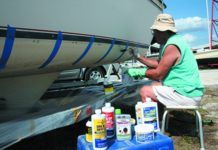Flaking Hull Liner
I have a 1969 Sea Sprite which has a rough textured interior that continues to flake off. Do you know of a practical solution to this problem?
Bill Staples
Rochester, New York
We guess the answer to your question depends in part on the type of material used on your hull sides. If it sands, wed take off as much as possible and paint or cement a new liner over whats left of the old. If only adhesive is left, you might try some type of solvent. But our guess is that anything dry enough to flake is a candidate for sanding or wire brushing.
DGPS: Manual or Automatic?
The last time we came up the ICW from Florida to Annapolis, we had a Garmin GPSMAP 175, which we found to be a great help. But, we were frequently annoyed by the selective availability (SA) that caused the GPS to show our track passing through the shore alongside the ICW. We are thinking seriously about getting a DGPS before going south again next fall. But which one?
Since we have a Garmin GPS, the Garmin GBR 21 DGPS receiver comes to mind immediately. But we note that Garmin has been selling this same model for quite some time, and we wonder if the GBR 21 may already be a dinosaur in the rapidly changing electronic world. For example, we see that West Marine has a new Automatic GPS with digital signal processing that they claim will work fine with our Garmin GPS.
Well, automatic (instead of manual) station selection sounds like a real improvement, but is it really? And is digital signal processing really better than analog for this kind of equipment? Clearly, we need Practical Sailors help.
Bradshaw Armendt, Jr.
Bel Air, Maryland
DGPS or differential global positioning system, as you know, is intended to eliminate or at least reduce errors caused by SA as well as atmospheric and satellite errors. DGPS receivers stationed along the coast make measurements of each visible satellite, calculating the difference between true and observed ranges. This data is then transmitted to the DGPS receiver on your boat, which then can correct its range measurements, giving you a more accurate position.
As you travel up and down the coast, your receiver will move beyond the transmission range of one tower and move into another. In between, there will be periods of overlap. A manual DGPS receiver requires that you select which station you want to receive, usually with a dial on the unit. An automatic receiver determines the best signal and locks onto that station. Automatic station selection is probably worthwhile for those, like you, who are traveling considerable distances along the coast. If, on the other hand, you do all of your boating on the Chesapeake Bay, youd most likely only use one station, so no manual selections would be necessary after the first.
Digital signal processing is said to have increased operating range and more efficient data modulation when the signal is weak. It is not necessarily more accurate.
The West Marine DGPS receiver, made for them by an electronics company, has a 12″ whip antenna and sells for $499, same as the manually tuned Garmin GBR 21. A minor consideration is that the Garmin product will plug into your Garmin GPS, whereas the West Marine receiver must be hardwired through a junction box. Though its only a few wires, its not quite as clean.
So, for cruisers, automatic DGPS is probably the smart choice. For others, who do all or most of their sailing in one area, a manual receiver made by the manufacturer of their GPS is satisfactory.




































